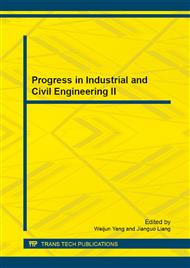p.369
p.373
p.378
p.386
p.390
p.396
p.402
p.406
p.411
3D Finite Element Analysis of Negative Skin Friction (NSF) Behaviors in Pile Groups with Cap
Abstract:
The pile-soil interactions are constrained by the pile cap in pile groups with cap, while mutually independent in pile groups without cap. The mechanism of changing of NSF in pile groups with cap are analyzed briefly. The NSF behaviors of pile groups with cap under the condition of groundwater level lowering are analyzed by three-dimensional finite element method. The analysis shows that the NSF of pile groups with cap is generally similar to that of a single pile: as the working loads on cap increasing, the neutral point moves up, additional settlement increases and the downdrag decreases, though there are differences between piles in different positions. The constraints of settlement of piles in various positions by the cap are significant when the working load is not large, so that the neutral point of piles are almost coincident. As the working load increasing, the deformation of the cap increases and the neutral point of piles become more various, lowest for the corner pile, second for the perimeter pile and highest for the interior pile. The NSF of each pile in pile groups with cap mobilizes differently along the depth. It is mobilized most fully for the corner pile, second for the perimeter pile and least for the interior pile.
Info:
Periodical:
Pages:
390-395
Citation:
Online since:
September 2013
Authors:
Price:
Сopyright:
© 2013 Trans Tech Publications Ltd. All Rights Reserved
Share:
Citation:


